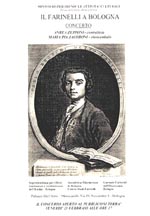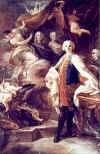|
CENTRO STUDI FARINELLI |
Farinelli in Bologna, an exhibition
held at the Soprintendenza per i Beni Ambientali e Architettonici di Bologna, on
the occasion of theTerza settimana della cultura, Ministero dei beni e delle
attività culturali (23
February-2 March 2001).
Review:
La Repubblica, Bologna, 23
febbraio 2001
The exhibition was rearranged at the Istituto Italiano di Cultura in Slovenia,
on the occasion of the Third Centenary of the Academia Philharmonicorum
Lubacensis (Lubiana 3-30 December 2001); in the city of Andria on
Farinelli's birth-300th anniversary (March 8-15
2005) and at the Museo
internazionale e biblioteca della musica di Bologna (April 6-30,
2005).
 |
LIST OF THE DOCUMENTS EXHIBITED
VISIT THE PAGES OF THE ON LINE EXHIBITION
 D
D
The Exhibition Il Farinelli a Bologna, set up in the premises of Palazzo
Dall’Armi Marescalchi , seat of the Soprintendenza per I Beni Ambientali e
Architettonici dell’Emilia, from 23 February to 9 March 2001, on the occasion
of the third Week of Culture promoted by the Ministero per I Beni e le Attività
Culturali, gathers for the first time about 250 reproductions of documents,
letters, images and paintings scattered all over the world,
some of which of difficult availability; particular attention is devoted
to the reconstruction of the environments and of the atmosphere of Farinelli’s
villa, which is lost today.
With the exhibition Il Farinelli a Bologna, the collaboration between the
Soprintendenza ai Beni Ambientali e Architettonici dell’Emilia and the
Accademia Filarmonica of Bologna continues, after its start in 2000 with a
Concert for the jubilee restorations, during which Wolfgang Amadeus Mozart’s
assignment for the aggregation to the Accademia Filarmonica (1770) was exhibited.
The exhibition has been arranged for by Luigi Verdi, with the historical and
iconographic collaboration of Francesca Boris and Carlo Vitali, two of
the most important experts on Farinelli
who are also authors of the fundamental essays “Carlo Broschi Farinelli.
La solitudine. Lettere al conte Sicinio Pepoli (Palermo, Sellerio 2000),
with the collaboration of Vincenzo Lucchese, Leonardo Marinelli and Paola Monari.
The picture-frames have been
provided for by Bruna Toneatto’s “Le piccole cose” . The exhibition has
been opened by an intervention of Elio Garzillo, Sovrintendente ai Beni
Ambientali e Architettonici dell’Emilia Romagna, and by a concert of
contraltist Andrea Zepponi and harpsichordist Maria Pia Jacoboni.
The exhibition is divided in 9
sections, chronologically arranged in 50 panels: the early Bolognese success;
The relation with Bologna during the Spanish years; Most famous guests at Villa
Farinello: Gluck, Giuseppe II, Burney, Mozart, Casanova; Family life in villa;
The late years; Farinelli’s death; The villa and Farinelli’s wealth after
his death.
